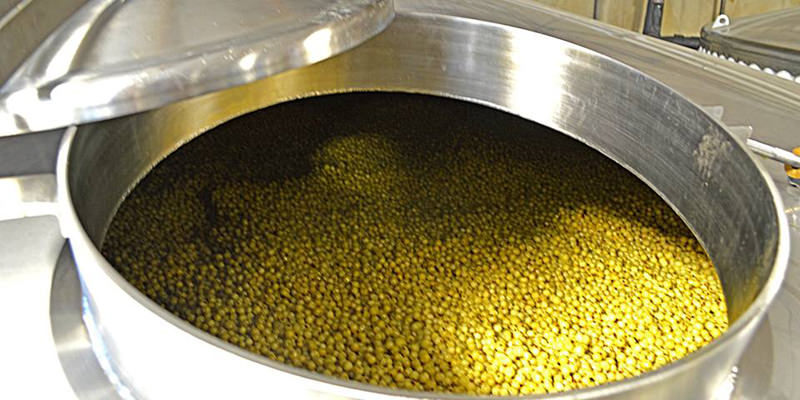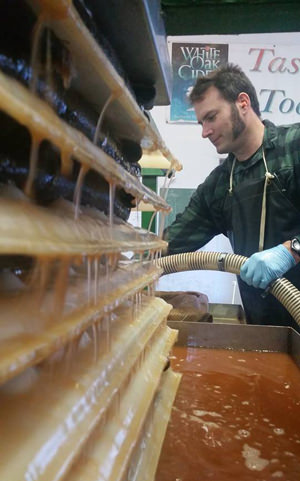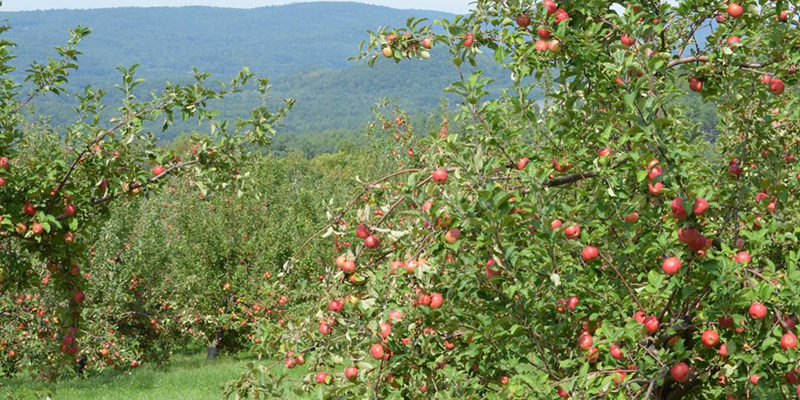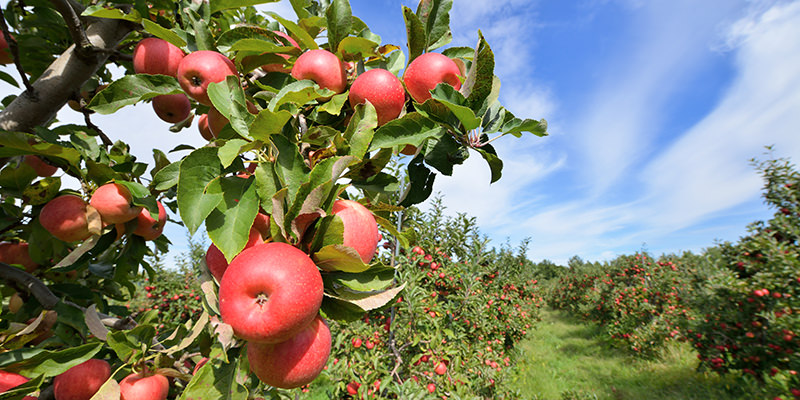Cider didn’t used to be so sexy. Its image – a sipper for a country granny while she kicks it in her rocking chair and talks to her cat – is a marketer’s worst nightmare. But cider, undeniably, is having a moment.
Cider hits the current zeitgeist in several sweet spots: it’s artisanal, farm-to-table, and an embodiment of terroir, as well as a small batch heirloom product. Cider has found traction with beer and wine drinkers, locavore enthusiasts, urbane hipsters – and the gluten-free crowd. So yes, essentially everyone.
Sales rose 75.4% between November 2013 and November 2014, to roughly $400 million, according to IRI Worldwide, a market research company. Cider production tripled between 2011 and 2013, making it the fastest-growing segment of the beer and malt beverage market, even though it still only accounts for 1% of the overall market share, meaning it has nearly untappable potential for future growth.
And news flash to the (few) remaining doubters: cider is no longer relegated to the Wine Cooler ghetto of your favorite strip mall’s liquor warehouse. Dozens of varieties are being honored with wine list inclusion at such temples of gastronomy as the Gramercy Tavern and Eleven Madison. (Wine list bragging rights are key to a beer, wine or liquor’s success – often focused on with more urgency than social media campaigns, press outreach and ad spending – and can catapult what used to just be a neighborhood brew into a national player.)
The stuff on tap at prestigious restaurants around the country doesn’t resemble the much-maligned supermarket cider made from apple juice concentrate and sugar, fermented and then force-carbonated and sweetened again before shipping and more reminiscent of a fizzy, alcoholic Hi-C than an apple.
“The hard cider industry is in the same place right now that craft beer was 10, 15 years ago,” Dave Takush, Cidermaker and Co-owner of 2 Towns Ciderhouse in Corvallis, Oregon, told VinePair. “The drinking public understands so much more about artisanal production thanks to the exploding craft beer and local wine scenes across the country. For the first time since Prohibition, farmers are starting to plant cider apples trees because they know that there is a money-making opportunity. The same thing happened with hop farming. It used to be that minimal varieties of hops were planted just for large producers, but when farmers realized that craft brewers wanted different hop varieties, a symbiotic relationship developed between regional brewers and farmers, and real collaborations emerged.”

Unexpected collaborations are driving much of the enthusiasm for the small-batch hard cider market. The roughly 350 makers in the U.S. sometimes wild-ferment their products, or add commercial Champagne yeasts, they’re often unfiltered, they’re hop-happy and many have unusual fruits (like 2 Town’s lush Made Marion, made with fresh-pressed apples and locally grown marionberries) added to the mix. Some are barrel-aged. Hand-crafted ciders made in America can be sweet and juicy, and some are tongue-cluckingly dry. It all depends on the apples used, and the style of production.
Just looking at the overall crop data, cider makers should be knee-deep in apples right now. The harvest this year was strong: while forecasters predict that this year won’t be quite as strong as last year’s bushel-busting harvest, for the most part it has been excellent (with the exception of Washington State, which had a lower harvest than usual due to weather issues).
In the Northeast, 2015 may even exceed last year. The U.S. Apple Association reports a 14% higher harvest in New England than last year, and an 18% higher harvest than the five-year average. All told, New England apple production will come in at just shy of 170 million pounds in 2015. Nationwide, U.S. Apple forecasts a crop of 234.8 million bushels (compared to 272.2 million bushels in 2014).
But an apple isn’t just an apple when it comes to making cider. “Hard ciders got a bad rap because most commercial makers were using just culinary apples, which can lead to syrupy sweet ciders,” Abram Goldman-Armstrong, 37, owner of Cider Riot!, a Portland cidery, explains. He cut his cider-making teeth planting cider apple trees at White Oak Cider in rural Washington, and confesses to being a home-brewer since he was 17.
“White Oak was way ahead of its time,” Abram says. “Twenty years ago, most Americans weren’t ready for traditional English ciders that were barrel-aged and had sharp, tannic flavors. But now, the market is there. People are educated about what traditional European cider tastes like, and I could probably double my production – if I had enough apples.”

While cider apples are actually higher in sugar than most dessert apples, they are known as “spitters” because of their bitter, acrid taste when eaten off the tree. (The reason most cider apple orchards were converted during Prohibition is that they simply wouldn’t sell as eating or cooking apples.) When fermented into cider though, those bitter and tannic flavors create layers of complexity, aroma and intrigue simply not available in the prosaic dessert variety.
The one thing stymieing the upward projection of ciders made from time-honored European techniques is, ironically in a banner harvest year, a dearth of the right kind of apples, the key to the flavors both makers and the market seem to crave.
“There are hundreds of types of cider apples, and they were chosen and evolved over time in cider-making regions, much like wine grapes were chosen and cultivated,” Abram said. “Cider apples have a ton of sugar, but not much water. True cider apples will have a ton of flavor, and after the sugar converts to alcohol during the fermentation process, you’re left with a ton of flavor. Cooking apples also have high sugar, but they’re so full of water and not as many tannins so the end-result is a lot more bland and sweet.”
There are three main regions of the world that have been producing ciders for centuries: Southwest England, Northwest France and Northern Spain. The manner in which the ciders are produced varies, as does the specific varietal of apple used. There are four main types of cider apples, according to Long Ashton Research Station in UK, which categorized them according to sugar levels. Sweets are low in tannins and acidity, sharps are high in acid and low in tannins, bittersweets are low in acid and high in tanning and bittersharps are high in acid and tannin. Acidity can add bite, while tannins can add astringency and bitterness, but also structure.
This isn’t the first time in our country’s history that Americans are lustily consuming European-style cider. Cider was America’s first alcoholic drink, and one of its most popular. Back in the day, we cranked out traditional ciders made from cider apple trees, until Prohibition came to apple country. In the decades after Prohibition, syrupy sweet ciders were really the only thing commercially available.
Most small-batch cider makers in the U.S. who want to honor at least some traditional components of cider making, are also orchardists, but it’s slow-going. Hard numbers are tough to come by, but even the most dedicated cider apple enthusiasts aren’t capable of throwing in more than one-third bitters to sweets. Dave says that a lot of cider-makers in America have come to appreciate the potential in dessert apples.
“You can make an excellent, world-class bottle of cider out of any apple variety, even the desserts,” Dave explains. “You can’t make Normandy-style cider with dessert apples, but you can make an amazing New World variety just of out culinary apples. It comes down to technique, the varieties of dessert apples you pick – some have more sharpness and acidity – and they way you ferment and age it. That said, the craft cider industry and the market is moving toward focusing on the more traditional style, which means we need more cider apples.”
Cider Riot cranks out about 17,000 gallons of blended cider (about 20% is cider apples, 80% is dessert, he says), using traditional English and French cider apples from his roughly 8-acres of cider apples. (He also blends in apples from his parent’s 30 wild apple trees growing at their home in Oregon.) 2 Towns produces about 15,000 bottles annually from 400,000 pounds of specialty, heirloom and traditional cider fruit apples. For the past few years, they have planted 700 new cider apples on the banks of the Willamette River each year.
As anyone in the cider apple-growing business will tell you though, it takes a while for the trees to mature and produce the kind of mature, full-flavored fruit that cider makers need. Abram points to Poverty Lane Orchard & Farnum Hill Ciders as the nascent industry’s secret weapon. They’ve been growing cider apple trees commercially longer than anyone else in the country, and unlike other industries where competition eliminates the possibility of cooperation and competition, the cidery’s proprietors, growers and makers, Stephen Wood and Louisa Spencer, actually give away their trees to new cider-makers. For free.

“Through a mix of happenstance in the 1980s as the dessert apple industry was collapsing and we were searching for different streams of revenue and happened to personally know several English cider makers,” Stephen says. “We started small and tried hundreds of different grafting trials until we figured out what worked, and what didn’t. In 1989, we planted 5 acres, with just 1,000 trees, a very low density model that a lot of new commercial cider apple growers don’t follow because it may seem more expensive at first, but produces better quality fruit.”
A decade later, they became an officially bonded winery, and when newbie cider makers approached them for advice and help in growing cider apple trees, they started sending out grafting material so they could plant their own from Poverty Lane’s successful varietals. They also supply many cider makers around the country with fresh-pressed juice from their cider apple trees and cider apples, shipped whole. While Poverty Lane clearly has enough cider apples to produce 100% bitter cider, they produce a blend too.
“Our style is not having a style,” Stephen says with a note of wryness. “We started realizing that even though we were growing English and French varietals, we were encountering flavors, scents and structures in our fruit that we never saw in England or France. And for us, we like the flavor profile that a mix of cider and dessert, roughly 75% bittersweets to 25% cooking, brings to the table. But we choose our cooking apples carefully. We would never use a Macintosh for example. Never!”
Cider apples have so much personality, many facets of which are distinct and dependent on their unique balance of tannins and sugar, not to mention the geographic region in which they’re cultivated, Stephen predicts that in several decades, certain cider apples varietals will be cultivated regionally in America.
“I don’t know if I’ll see it in my life, but I believe that eventually, the market will make qualitative judgments about varietals,” Stephen says. “Just like a Cabernet Sauvignon produced in Napa Valley commands a higher price tag and is considered superior to one produced in Central Valley, there are going to be certain cider varietals that will define one region versus another. We have learned through decades of experiments that terroir comes into play with how different flavor profiles can be teased out of apples depending on where they’re grown.
Volume sales for hard cider increased 278% between 2010 and 2014, and the only thing hampering the continued growth of the industry is the buzz-kill inducing lack of real cider orchards. What is a maker to do? Farmers and scientists at the University of Vermont, the University of Michigan, Cornell University, Virginia Tech and Washington State University are working with the USDA and the U.S. Apple Association to distribute millions of dollars in grants and research initiatives to get more cider apple trees successfully growing, and determine which varietals grow best where – and which ones the market enjoys.
While big brands like Angry Orchard, Woodchuck and Johnny Cider still dominate the market (with 56.8%, 10.5% and 5.6% of the market share, respectively), small-batchers are catching up. 2 Towns brought in 1.4% of the market share, according to IRI. Not bad for three childhood friends in their 20s operating on a shoestring budget since 2010.
“I have to say the support of our local community has been a huge,” Dave says. “From the people who are willing to expand their palates with our experimental brews to the farmers who have contracted to grow apples with us, to the restaurants and bars who serve our ciders – it’s all a collaboration and a cooperative effort. We are excited to be on the front lines of the cider revolution.”
And we’re excited to sip the spoils. My current favorites include:
2 Towns Ciderhouse: Hop & Stalk, one of 2 Town’s flagship ciders is made with Citra hops and locally grown rhubarb for an extraordinarily floral brew. It’s also citrusy-bright and bone dry. The dry-hopped character adds unexpected structure and complexity.
Cider Riot!: 1763 commemorates the year of the Cider Riots in England, when cider lovers overthrew the cider-taxing Prime Minister. It evokes traditional West Country ciders with robust tannic structure and luxuriously rich, deep and complex notes of apple.
Poverty Lane Orchards & Farnum Hill Cider: Farnum Extra Dry Still is bubble-free, and nothing but New Hampshire-grown cider apples. It is radically dry, still and vivid, one of the purest and most daring essences of apple on the market.
Soon, as the young cider apple trees Farnum has been responsible for planting across the country blossom into maturity, we should have more sips for thought – and perhaps, a developing understanding of how terroir and cider apple varietals intersect.

